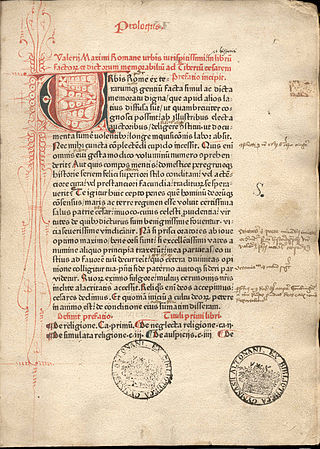
An incunable or incunabulum is a book, pamphlet, or broadside that was printed in the earliest stages of printing in Europe, up to the year 1500. Incunabula were produced before the printing press became widespread on the continent and are distinct from manuscripts, which are documents written by hand. Some authorities on the history of printing include block books from the same time period as incunabula, whereas others limit the term to works printed using movable type.

Year 1519 (MDXIX) was a common year starting on Saturday of the Julian calendar, the 1519th year of the Common Era (CE) and Anno Domini (AD) designations, the 519th year of the 2nd millennium, the 19th year of the 16th century, and the 10th and last year of the 1510s decade.
This article is a list of the literary events and publications in the 15th century.
This article contains information about the literary events and publications of 1500.

The Supercopa de España, also known as the Spanish Super Cup, is a super cup tournament in Spanish football. Founded in 1982 as a two-team competition, the current version has been contested since 2020 by four teams: the winners and runners-up of the Copa del Rey and La Liga.

Johannes Oporinus was a humanist printer in Basel.
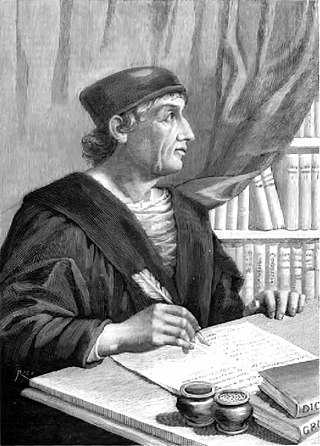
Antonio de Nebrija was the most influential Spanish humanist of his era. He wrote poetry, commented on literary works, and encouraged the study of classical languages and literature, but his most important contributions were in the fields of grammar and lexicography. Nebrija was the author of the Spanish Grammar and the first dictionary of the Spanish language (1495). His grammar is the first published grammar study of any modern European language. His chief works were published and republished many times during and after his life and his scholarship had a great influence for more than a century, both in Spain and in the expanding Spanish Empire.
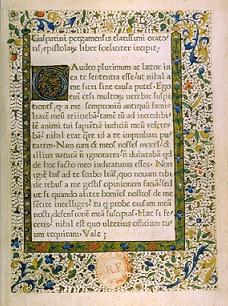
Johann Heynlin, variously spelled Heynlein, Henelyn, Henlin, Hélin, Hemlin, Hegelin, Steinlin; and translated as Jean à Lapide, Jean La Pierre , Johannes Lapideus, Johannes Lapidanus, Johannes de Lapide was a German-born scholar, humanist and theologian, who introduced the first printing press in France (Paris) in 1470.

Bibliotheca Philosophica Hermetica (BPH) or The Ritman Library is a Dutch library founded by Joost Ritman located in the Huis met de Hoofden at Keizersgracht 123, in the center of Amsterdam. The Bibliotheca Philosophica Hermetica brings together manuscripts and printed works in the field of Hermeticism, more specifically the 'Christian-Hermetic' tradition.

Chinese people in Spain form the ninth-largest non-European Union foreign community in Spain. As of 2009, official figures showed 145,425 Chinese citizens residing in Spain; however, this figure does not include people with origins in other Overseas Chinese communities, nor Spanish citizens of Chinese origin or descent.

Kasper Straube was a German 15th-century printer from Bavaria.

El Clásico or El Clàssic, both meaning "The Classic", is the name given to any football match between rival clubs Barcelona and Real Madrid. Originally referring to competitions held in the Spanish championship, the term now includes every match between the clubs, such as those in the UEFA Champions League, Supercopa de España and Copa del Rey. It is considered one of sport's fiercest rivalries, and its matches have a global audience of hundreds of millions. A fixture known for its intensity, it has featured memorable goal celebrations from both teams, often involving mockery from both sides.
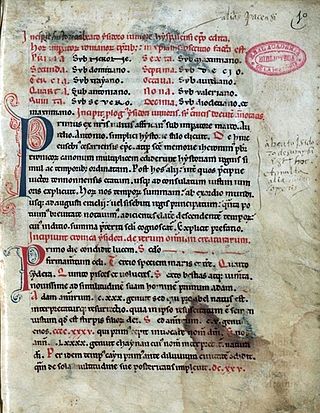
The Chronica Naierensis or Crónica najerense was a late twelfth-century chronicle of universal history composed at the Benedictine monastery of Santa María la Real in Nájera. In Latin it narrates events from Creation to its own time, with a focus on the Bible, classical history, the Visigothic in Spain, and the kingdoms of Castile and León. It was an important model for later Spanish Latin historiographers, notably the De rebus Hispaniae of Rodrigo Jiménez de Rada, the Chronicon mundi of Lucas de Tuy, and the Estoria de España of the patronage of Alfonso X of Castile.
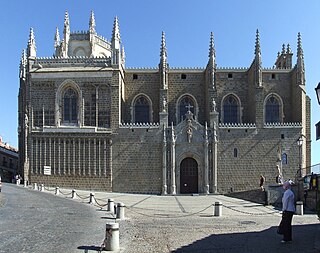
The Monastery of San Juan de los Reyes is an Isabelline style Franciscan monastery in Toledo, in Castile-La Mancha, Spain, built by the Catholic Monarchs (1477–1504).
The Chronica latina regum Castellae, known in Spanish as the Crónica latina de los reyes de Castilla, both meaning "Latin Chronicle of the Kings of Castile", is a medieval Latin history of the rulers of Castile from the death of Count Fernán González in 970 to the reconquest of Córdoba by King Ferdinand III in 1236–39. It was probably composed by Juan de Soria, the Bishop of Osma and chancellor of Ferdinand III, between 1217 and 1239. The majority of the text deals with the reigns of Alfonso VIII (1158–1214) and Ferdinand III (1217–1252). It was designed with two purposes: for use at the royal court as a speculum principis and to defend the interests of Castile against those of the Kingdom of León.

Guido de Monte Rochen or Guy de Montrocher was a French priest and jurist who was active around 1331. He is best known as the author of Manipulus curatorum, a handbook for parish priests, that was often copied, with some 180 complete or partial manuscripts surviving, and later reprinted throughout Europe in the next 200 years, with at least 119 printings, and sales which have been estimated to be three times those of Thomas Aquinas' Summa Theologica. It became obsolete only when the Council of Trent created the Roman Catechism in 1566.

Pablo Hurus was a German printer of the late 15th-century, active in Zaragoza, Aragon during the years 1484 to 1499. With his brother Juan, he established one of the important early printing shops of the Iberian peninsula, predated only by the Sevilla printing shops of Menrad Ungut and Estanislao Polono.
There are several notable football rivalries in Spain, some of which attract worldwide attention.
Pedro Juan Núñez was a Valencian humanist and educator active during the Spanish Golden Age. He is famous for his rhetorical treatises based on Hermogenes' rhetorical works.














